Argiope
by Valerie (October 25, 2001)
revised September 23, 2004
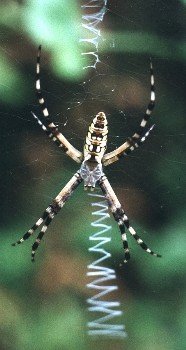
The largest orb weaver in our gardens is the black and yellow argiope (Argiope aurantia). Actually, only the female is large, the males being much smaller by comparison. Although big enough to deliver a bite, these spiders are not poisonous or aggressive. The black and yellow argiope is also called banana spider, yellow garden spider, zipper spider, golden orb weaver and writing spider. There are a number of other species in the genus Argiope, but most that occur in the U.S. are restricted to tropical climates. A related species inhabits gardens in Europe. Because they make such big webs and are brightly colored, it is impossible for a resident argiope to remain unnoticed in the garden or, as they sometimes look for sheltered areas, on the side of a house. We had one spider who thought the ideal location for her web was right by our front door over the doorbell. She stayed there all summer, enjoying frequent feedings of any large insects we could find to throw into her web. 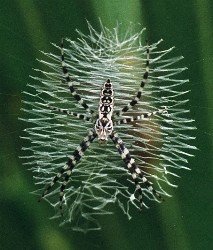
The argiope spiders make excellent photography subjects because they don't react to the camera lens. Part of the reason is probably their rather poor vision, as they do not rely on sight to catch prey, but on the vibrations produced in their webs. Smaller orb weavers, like members of the genus Araneus, which also inhabit our yard, sometimes make webs even bigger than the argiopes, but they are very difficult to photograph. Maybe because they are small and tasty morsels for birds, these spiders do not sit in the middle of their web during the day, but usually hide in a nearby leaf at the base of one of the web support strands. If they happen to be in the middle of the web, my approach with the camera almost always makes them retreat to a safe hiding place. In spite of their large size and the care with which they place their webs, the argiope spiders in our yard are often taken by predators such as birds.
An interesting feature of many orb webs is the central white design created by the spider, called a stabilimentum (referring to the idea that it helps stabilize the web). With argiopes, this area is almost round and filled in with many zigzags of silk when the spider is young, but as it grows, the design changes to be more of a single vertical zigzag. Spiders are capable of creating as many as seven different kinds of silk using several different glands that supply the spinnerets.
In order to grow, spiders must periodically shed their exoskeletons. This is a fascinating process to watch, but one which leaves the spider very vulnerable until its new skin hardens. When the spider is about to shed, the inside layers of its skin are digested. It anchors its legs on part of its web, hanging upside down. The top of the carapace splits open and the spider literally falls out of its old shell. It doesn't fall because it is anchored by a strand of silk from its spinnerets. As soon as the spider is completely free of its old skin, it hangs limp for awhile, then spreads its legs out to let them dry. The females are easy to spot in their webs, but the males (photo at right) tend to be harder to find. When they are young, both the males and females look similar, but the males seem to never grow much, while the females become quite large. The males also do not remain in their original area if there is no female around. Once they mature, they must search out a female with whom to mate. Often, it is possible to find the tiny males living in their small webs just to the side of a female's large web. While both genders of argiopes have the habit of holding their legs in an X pattern, the males seem to make the posture more pronounced, possibly as an aid to their protective camouflage.
Just before laying eggs, the female spider is often quite large, her abdomen considerably distended. Argiopes produce large numbers of young in their egg sacs. Like many spiders, argiopes live only one year, expending all their energy into producing eggs (females) or sperm (males). They die once winter arrives. |
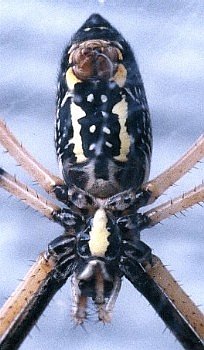
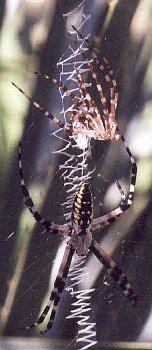 The photo at left shows the underside of an adult female argiope. The spinnerets appear as a group of brown structures forming an irregular shaped disk. The different types of silk have varying amino acid compositions. The silk coming out of the spinnerets can vary from an extremely fine single line, like those used to create the main support lines on their web, to wide ribbons of silk used for subduing prey or making the central design on their web. Spiders can vary the stickiness of the silk as well as it's thickness. The purpose of the central design in many spiders' webs is not completely understood. It could serve several purposes, including a way to conceal the spider from its prey or its predators (which could explain why the patch is more disruptive for small, young spiders than for large ones), a way to keep birds from blundering into the web, or a lure for insects, as the silk reflects ultraviolet light in much the same way as do flower centers. Another spider habit that has never been fully explained is that of hanging upside down in the web. Almost all spiders do this but I've never heard a definitive explanation.
The photo at left shows the underside of an adult female argiope. The spinnerets appear as a group of brown structures forming an irregular shaped disk. The different types of silk have varying amino acid compositions. The silk coming out of the spinnerets can vary from an extremely fine single line, like those used to create the main support lines on their web, to wide ribbons of silk used for subduing prey or making the central design on their web. Spiders can vary the stickiness of the silk as well as it's thickness. The purpose of the central design in many spiders' webs is not completely understood. It could serve several purposes, including a way to conceal the spider from its prey or its predators (which could explain why the patch is more disruptive for small, young spiders than for large ones), a way to keep birds from blundering into the web, or a lure for insects, as the silk reflects ultraviolet light in much the same way as do flower centers. Another spider habit that has never been fully explained is that of hanging upside down in the web. Almost all spiders do this but I've never heard a definitive explanation.
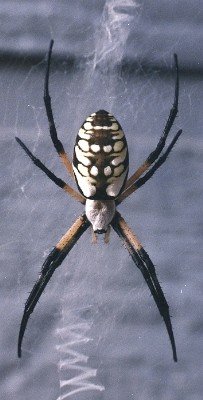 In the photograph above at right, the old skin is visible at the top, while the spider hangs below. At this point the spider is expanding its size, and it can even grow a new limb if one was lost before.
In the photograph above at right, the old skin is visible at the top, while the spider hangs below. At this point the spider is expanding its size, and it can even grow a new limb if one was lost before.

 Although one sac seems to be the norm, we saw one female produce three over a period of a couple of weeks and have heard of a single spider producing four and still going strong. Unlike some spiders, such as the green lynx, who guard their eggs and young, argiopes tend to leave their eggs to their fate. The egg case looks like a miniature Greek wine vessel, with a bulbous shape and a little round neck at the top. The color of the egg case is brown and it is anchored within a framework of silk strands, keeping it away from surrounding vegetation. Although this protects the case from some predators, like ants, other predators and parasites lay their eggs within the cases as well. These tenants include other species of spiders as well as wasps. The young spiders hatch in the fall but overwinter in the egg case. These cases are very well constructed and we've seen them last not only through the winter, but through another year as well, before the weather eventually takes its toll and they are washed away.
Although one sac seems to be the norm, we saw one female produce three over a period of a couple of weeks and have heard of a single spider producing four and still going strong. Unlike some spiders, such as the green lynx, who guard their eggs and young, argiopes tend to leave their eggs to their fate. The egg case looks like a miniature Greek wine vessel, with a bulbous shape and a little round neck at the top. The color of the egg case is brown and it is anchored within a framework of silk strands, keeping it away from surrounding vegetation. Although this protects the case from some predators, like ants, other predators and parasites lay their eggs within the cases as well. These tenants include other species of spiders as well as wasps. The young spiders hatch in the fall but overwinter in the egg case. These cases are very well constructed and we've seen them last not only through the winter, but through another year as well, before the weather eventually takes its toll and they are washed away.